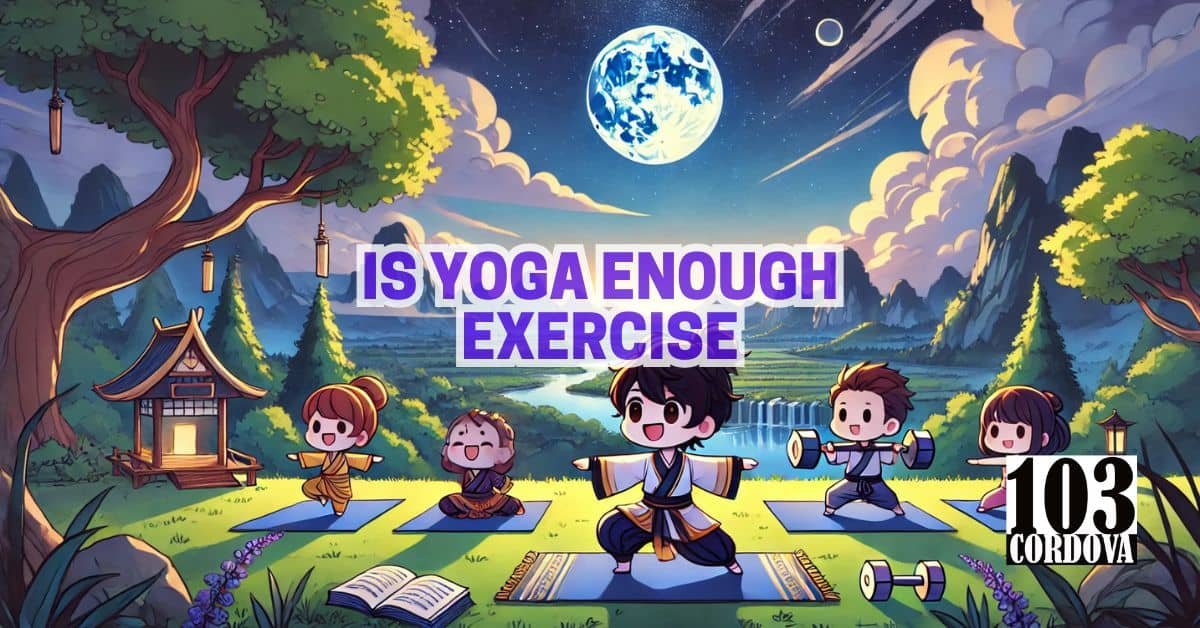Yoga is widely valued for its physical and mental benefits, yet some people question whether it’s enough as a standalone workout.
Unlike many high-intensity exercises, yoga combines gentle stretching with balance and controlled breathing.
This approach has made yoga a popular choice for people looking for a more mindful form of fitness.
However, for those with specific fitness goals, such as weight loss or building strength, the question arises if yoga alone can meet those needs.
Let’s examine how yoga compares to other workouts in areas like intensity, calorie burn, strength building, and more.
1. Understanding Yoga: What It Offers as Exercise
Yoga emphasizes a balanced approach, combining physical movement with breathing techniques to benefit both the mind and body.
Its poses, called asanas, range from simple stretches to more complex positions that require flexibility and strength.
By incorporating controlled breathing, yoga helps reduce stress and improve mental clarity, giving it a holistic edge over some purely physical workouts.
Certain yoga styles, like Hatha, are more calming, while others, like Vinyasa, are physically demanding.
Overall, yoga provides a unique experience that supports general fitness, calmness, and improved flexibility.
🧘 Yoga Is What Type Of Exercise? A Deep Dive into Its Categories
2. Intensity Levels: How Yoga Compares to Other Workouts
Yoga offers a range of intensity levels, but they typically don’t match high-intensity exercises like running or weightlifting.
Gentle styles like Hatha are low in intensity and focus on relaxation and slow stretches, making them ideal for beginners or those with limited mobility.
Meanwhile, power Yoga or ashtanga are more demanding, as they involve fast-paced movements and require physical strength.
Despite these options, yoga is usually moderate in intensity, which may not meet the high-energy needs of people who prefer intense cardio or high-impact exercises.
Therefore, while yoga can be challenging, it generally does not raise the heart rate as much as some other fitness activities.
🧘 Pilates or Yoga: Understanding the Key Differences and Similarities
3. Caloric Burn: Is Yoga Enough for Weight Management?
Yoga burns calories, but the rate is often lower compared to cardio or high-intensity workouts.
A gentle session might only burn around 150 calories per hour, while a vigorous Vinyasa session can burn closer to 400 calories.
For comparison, an hour of running or cycling usually burns far more, making these better choices for fast calorie loss.
Some people find yoga effective for weight management because it improves metabolism and encourages mindful eating.
While yoga alone can contribute to weight control, those looking to lose weight quickly may benefit from adding high-calorie-burning exercises.
🧘 How to Choose the Right Yoga Classes Online for Beginners: Tips for Success
4. Building Strength: Yoga vs. Traditional Strength Training
Yoga builds strength by using bodyweight resistance in poses that target multiple muscle groups at once.
Poses like Plank, Warrior, and Downward Dog require muscle engagement, helping to build endurance and stability over time.
However, yoga does not provide the same targeted muscle growth as traditional strength training, which uses weights or machines to develop specific muscles.
Weightlifting allows for precise control over resistance and is often more effective for people looking to build large muscle mass quickly.
While yoga strengthens muscles, it emphasizes functional, full-body strength rather than isolated muscle growth.
🧘 Yoga Exercises for Seniors: Creating a Home Practice for Wellness and Relaxation
5. Flexibility and Mobility: Unique Benefits of Yoga
Yoga is particularly effective for improving flexibility and mobility, areas often overlooked in other forms of exercise.
Regular practice of yoga stretches muscles, tendons, and ligaments, gradually increasing range of motion.
Poses like Forward Fold and Pigeon are specifically designed to release tension and enhance flexibility, which supports joint health and prevents stiffness.
Unlike many traditional workouts, yoga’s focus on stretching also reduces the risk of injuries by preparing muscles for a wider range of movements.
This unique benefit makes yoga a valuable addition to any fitness routine, especially for those aiming to improve flexibility.
🧘 Safety Tips for Practicing Yoga for Seniors Over 60
6. Cardiovascular Health: Comparing Yoga to Cardio Workouts
Some forms of yoga, like Vinyasa or Power Yoga, elevate the heart rate, providing mild cardiovascular benefits.
However, even active yoga does not typically raise the heart rate as much as cardio exercises like running, cycling, or aerobics, which are designed specifically to improve cardiovascular health.
Cardio exercises build endurance by strengthening the heart and lungs, something yoga can only partially support.
For those focused on improving heart health, traditional cardio may be more effective than yoga alone.
Yoga can complement cardio by providing flexibility and mental benefits, but it may not replace cardio for cardiovascular fitness.
🧘 Exploring the Benefits of Chair Yoga for Seniors: A Gentle Path to Wellness
7. Mental Health: Comparing Yoga’s Emotional Benefits to Other Exercises
Yoga is highly regarded for its mental health benefits, as it combines physical movement with breathing techniques and mindfulness.
These elements work together to reduce stress, enhance focus, and promote emotional well-being, making yoga particularly helpful for those managing anxiety or depression.
While other exercises also improve mood by releasing endorphins, yoga’s mindfulness aspect uniquely targets stress reduction and mental clarity.
The controlled breathing used in yoga activates the body’s relaxation response, calming the nervous system more than many other workouts.
For this reason, yoga is often chosen by people looking for both physical and mental relaxation.
🧘 How Yoga for Seniors Over 70 Can Improve Balance and Stability
8. Injury Prevention: Can Yoga Help You Stay Injury-Free?
Yoga’s slow and controlled movements reduce the impact on joints and muscles, making it a safer option for many people.
Poses focus on balance, alignment, and flexibility, which can help improve body mechanics and reduce strain during other activities.
Regular yoga practice strengthens stabilizer muscles and promotes good posture, which can further protect against injuries.
However, it’s important to practice proper form, as holding poses incorrectly or pushing too far can lead to strains.
Yoga’s focus on body awareness and gentle movement makes it a helpful tool for maintaining physical health and preventing injuries.
🧘 How to Do Laughter Yoga to Cultivate Joy and Positivity
9. Adaptability: Making Yoga Accessible for All Fitness Levels
Yoga can be adapted to suit beginners, advanced practitioners, and everyone in between, making it one of the most inclusive forms of exercise.
Modifications, such as using props or adjusting poses, allow people with various fitness levels and physical limitations to participate.
A gentle yoga style like Hatha can introduce newcomers to the basics, while experienced individuals might choose more intense styles like Power Yoga.
Because yoga accommodates all fitness levels, it can be practiced by people of all ages and abilities.
This adaptability makes yoga an excellent choice for anyone looking to improve their health at their own pace.
10. Sustainability: Is Yoga a Long-Term Fitness Solution?
Yoga’s low-impact nature and variety of styles make it sustainable for long-term practice, unlike some high-intensity workouts that can cause wear and tear over time.
By focusing on both physical and mental well-being, yoga encourages a balanced approach that is less likely to lead to burnout.
Many people find yoga’s gentle approach easier to maintain consistently than routines that require heavy weights or fast-paced exercises.
Since yoga doesn’t overstrain the body, practitioners can continue well into later stages of life.
Yoga’s focus on holistic health makes it a sustainable choice for lifelong fitness and wellness.
🧘 103 Cordova Yoga Studio in Marikina City
💡 Conclusion
Whether yoga is enough exercise largely depends on personal fitness goals, such as weight loss, muscle building, flexibility, or stress relief.
Yoga may be sufficient for those seeking balanced health benefits, but it may need to be combined with other exercises for specific goals like intense strength or cardio improvements.
Yoga’s unique ability to support mental health and flexibility sets it apart, making it valuable even as a complementary practice.
For people who prioritize holistic wellness, yoga can serve as the foundation of a healthy lifestyle.
Ultimately, yoga’s benefits extend beyond physical fitness, offering a balanced approach that can support various fitness goals.
🧘 Our Services
Experience the benefits of yoga for every age with our inclusive classes at 103 Cordova Tower, Marquinton Residences, Marikina City.
Our sessions are designed to meet all skill levels, promoting flexibility, strength, and relaxation in a welcoming environment.
Whether you’re a beginner or an experienced practitioner, our instructors will guide you every step of the way.
To find out more or arrange your first class, contact us via our website’s contact form, Facebook page, or 09176225780.
Join us in nurturing both body and mind through the transformative practice of yoga.

